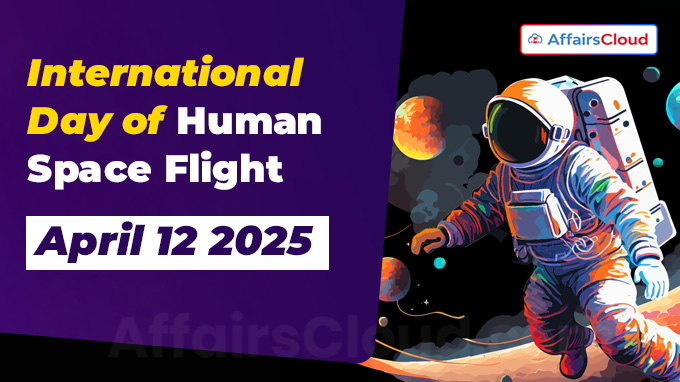 The United Nations (UN’s) International Day of Human Space Flight is annually observed across the world on April 12 to celebrate the beginning of the space era for mankind and highlights the pivotal role of space science and technology in promoting Sustainable Development Goals (SDGs).
The United Nations (UN’s) International Day of Human Space Flight is annually observed across the world on April 12 to celebrate the beginning of the space era for mankind and highlights the pivotal role of space science and technology in promoting Sustainable Development Goals (SDGs).
Background:
i.On April 07 2011, New York (the United States of America, USA)-based UN General Assembly (UNGA) adopted the resolution A/RES/65/271 and declared April 12 to be observed annually as International Day of Human Space Flight.
- The 1st ever International Day of Human Space Flight was observed on April 12, 2011.
ii.The year 2011 marked the 50th anniversary of the 1st –ever human spaceflight carried out by the Russian cosmonaut Yuri Gagarin of the Soviet Union on April 12, 1961.
- It also marked the 50th anniversary of the 1st session of the Committee on the Peaceful Uses of Outer Space (COPUOS).
iii.In order to celebrate the 1st International Day of Human Space Flight (April 12, 2011), New York (USA)-based UN Postal Administration (UNPA) issued a series of special commemorative stamps at each of its offices in New York (USA), Geneva (Switzerland), and Vienna (Austria), including a stamp featuring image of Yuri Gagarin.
Key Milestones Achieved in Outer Space Exploration:
i.Sputnik-I, the 1st human-made Earth satellite was launched by the Soviet Union into outer space on October 04, 1957.
ii.Russian Cosmonaut Valentina Tereshkova was the 1st woman to travel to space as well as 1st woman to orbit the Earth in 1963.
iii.American astronaut Neil Armstrong became the 1st human to set foot upon the surface of the Moon in 1969.
iv.Apollo-Soyuz spacecraft docked on July 17 1975, the 1st international human mission in space.
v.The 1st module of the International Space Station (ISS) was launched in November 1998. A Russian proton rocket launched the Russian Zarya (zar EE uh) control module.
UN and Space Exploration:
i.The UNGA adopted the 1st international human mission in space in recognition of the shared human interest in space and to address the question of how space can benefit humans.
ii.The UNGA adopted its 1st resolution 1348 (XIII) entitled ‘Question of the Peaceful Use of Outer Space’ in 1958.
iii.The pivotal ‘Magna Carta of Space’ or the Treaty on Principles Governing the Activities of States in the Exploration and Use of Outer Space, including the Moon and other celestial bodies, came into force on October 10, 1967.
Role of UNOOSA:
i.Vienna (Austria)-based UN Office for Outer Space Affairs (UNOOSA) is the UN office entrusted with the responsibility of promoting international cooperation in the peaceful uses of outer space.
ii.It serves as the secretariat for UNGA’s only Committee, the UN’s COPUOS, which deals exclusively with international cooperation in the Peaceful Uses of Outer Space.
iii.Apart from above-mentioned functions, UNOOSA implements the Secretary General’s duties under International Space Law and maintains the UN Register of Objects launched into Outer Space.
About United Nations Office for Outer Space Affairs (UNOOSA):
Director- Aarti Holla-Maini
Headquarters – Vienna, Austria
Established- 1958




